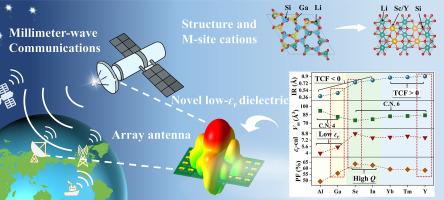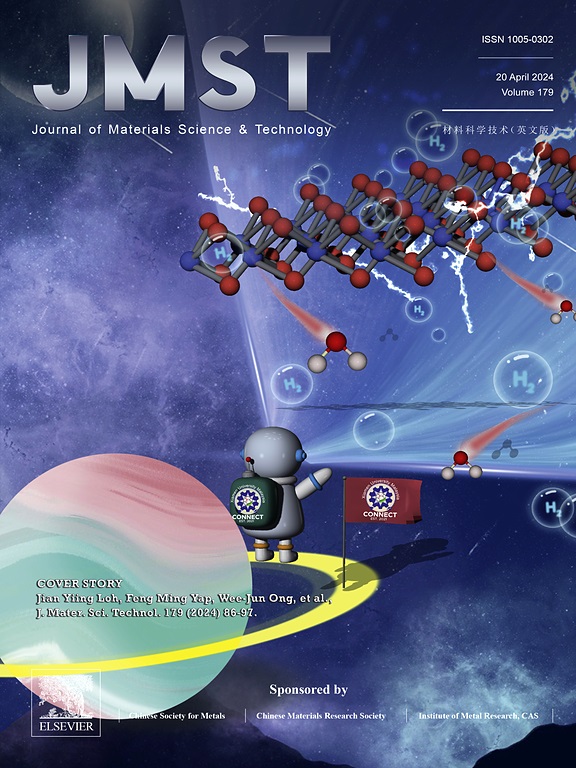LiMSiO4 (M = Ga, Sc and Y): Low-permittivity and high thermal conductivity microwave dielectric ceramics for millimeter-wave communications
IF 11.2
1区 材料科学
Q1 MATERIALS SCIENCE, MULTIDISCIPLINARY
引用次数: 0
Abstract
The advancement of millimeter-wave communication desires the ceramic substrate with low permittivity (ԑr) to meet the requirements of high transmission rates, low latency and wide bandwidth. However, the thermal conductivity of most low-ԑr ceramics is too low to deal with heat dissipation in millimeter-wave applications. In this paper, we reported novel dielectric ceramics LiMSiO4 (M = Ga, Sc and Y) with excellent performances of low ԑr (< 10) and high thermal conductivity (> 6 W mK−1). Their dielectric properties in both microwave and THz were investigated, where the LiGaSiO4 ceramic achieved the lowest ԑr of ∼5.2, the LiScSiO4 ceramic presented extremely low loss (Q × f ∼ 96,700 GHz, Q = 1/dielectric loss, f is resonant frequency), and the LiYSiO4 ceramic showed a positive temperature coefficient of f (TCF ∼ +32 ppm°C−1). The distinct dielectric behavior was subsequently studied by structure-performance relationship in terms of M-site cations and bond parameters using bond valence theory, Phillips–Van Vechten–Levine chemical bond theory and so on. Moreover, a 36 GHz microstrip array antenna was designed and simulated using the LiGaSiO4 ceramic substrate, obtaining high realized gain, high radiation efficiency and low sidelobe. The result demonstrated the great potential of LiMSiO4-type dielectric ceramics in millimeter-wave communications.

LiMSiO4(M = Ga、Sc 和 Y):用于毫米波通信的低渗透率和高热导率微波介质陶瓷
毫米波通信的发展需要具有低介电常数(ԑr)的陶瓷基板,以满足高传输速率、低延迟和宽带宽的要求。然而,大多数低ԑr 陶瓷的热导率太低,无法解决毫米波应用中的散热问题。本文报告了新型介电陶瓷 LiMSiO4(M = Ga、Sc 和 Y),具有低ԑr(10)和高导热率(6 W mK-1)的优异性能。研究发现,LiGaSiO4 陶瓷的ԑr 最低,为 5.2;LiScSiO4 陶瓷的损耗极低(Q × f ∼ 96,700 GHz,Q = 1/介质损耗,f 为谐振频率);LiYSiO4 陶瓷的 f 温度系数为正(TCF ∼ +32 ppm°C-1)。随后,利用键价理论、Phillips-Van Vechten-Levine 化学键理论等,从 M 位阳离子和键参数的结构-性能关系角度研究了这种独特的介电行为。此外,利用 LiGaSiO4 陶瓷基底设计并模拟了 36 GHz 的微带阵列天线,获得了高实现增益、高辐射效率和低侧射。该结果证明了 LiMSiO4 型介质陶瓷在毫米波通信中的巨大潜力。
本文章由计算机程序翻译,如有差异,请以英文原文为准。
求助全文
约1分钟内获得全文
求助全文
来源期刊

Journal of Materials Science & Technology
工程技术-材料科学:综合
CiteScore
20.00
自引率
11.00%
发文量
995
审稿时长
13 days
期刊介绍:
Journal of Materials Science & Technology strives to promote global collaboration in the field of materials science and technology. It primarily publishes original research papers, invited review articles, letters, research notes, and summaries of scientific achievements. The journal covers a wide range of materials science and technology topics, including metallic materials, inorganic nonmetallic materials, and composite materials.
文献相关原料
公司名称
产品信息
阿拉丁
SiO2
阿拉丁
Y2O3
阿拉丁
Sc2O3
阿拉丁
Ga2O3
阿拉丁
SiO2
阿拉丁
Y2O3
阿拉丁
Sc2O3
阿拉丁
Ga2O3
 求助内容:
求助内容: 应助结果提醒方式:
应助结果提醒方式:


